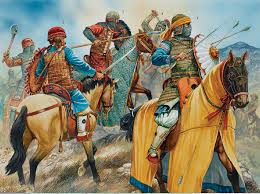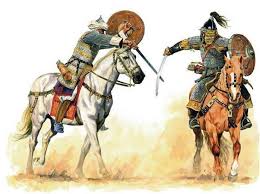Your basket is currently empty!
Introduction: A Pivotal Moment in World History
The Battle of Ain Jalut, fought on September 3, 1260, in the Jezreel Valley (modern-day Israel/Palestine), stands as one of the most strategically significant battles in global history. It was the first major defeat of the Mongol Empire, marking a crucial turning point that halted their westward expansion. This legendary clash between the Mamluk Sultanate of Egypt and the Mongol Empire had a lasting impact on the Middle East and beyond.
The Mongol Empire: An Unstoppable Force

By the mid-13th century, the Mongols, under Hulagu Khan—a grandson of Genghis Khan—had conquered vast territories across Asia and the Middle East. They destroyed Baghdad and toppled the Abbasid Caliphate, sending shockwaves through the Islamic world. With Syria already under Mongol control, the fall of Egypt seemed inevitable. Their brutal tactics, including psychological warfare, lightning-fast cavalry, and unmatched coordination, made them nearly invincible.
Rise of the Mamluks and Qutuz’s Leadership
Amid this chaos, the Mamluks, a military caste of enslaved warriors who rose to power in Egypt, became the last bastion of resistance. Sultan Saif ad-Din Qutuz, realizing the existential threat the Mongols posed, refused to surrender. He executed Mongol envoys, a bold declaration of war, and began preparing for battle. Qutuz united the Mamluk factions, motivated his troops, and devised a brilliant strategy to challenge the Mongol tide.
The Battle of Ain Jalut: Strategy and Execution

The Mamluk army marched north toward the Mongols, who were temporarily weakened by Hulagu’s withdrawal to Central Asia due to internal succession disputes. The remaining Mongol forces, led by Kitbuqa Noyan, confronted the Mamluks near Ain Jalut, meaning “Spring of Goliath.”
Using superior tactics, including a feigned retreat, the Mamluks lured the Mongols into a trap. Once the Mongol vanguard was drawn in, Mamluk heavy cavalry and archers launched a devastating ambush. The local terrain favored the Mamluks, who exploited it with discipline, mobility, and precise coordination.
Aftermath: A Turning Point in Global Power
The result was a crushing Mamluk victory. Kitbuqa was captured and executed, and the Mongol forces in the Levant were virtually annihilated. This triumph:
-
Saved Egypt and the rest of North Africa from Mongol domination
-
Preserved Islamic civilization in the region
-
Shattered the myth of Mongol invincibility
-
Solidified the Mamluk Sultanate as a dominant regional power for centuries
The victory at Ain Jalut proved that even the mightiest empire could be stopped by strategic brilliance and resolute leadership.
Legacy of Ain Jalut
The Battle of Ain Jalut remains a symbol of resistance and strategic genius in military history. It not only altered the course of the Crusades and Islamic history, but also influenced global geopolitics by preventing Mongol access to Africa and Europe. Today, Ain Jalut is remembered as one of the most decisive battles in history, comparable in impact to Thermopylae, Hastings, or Waterloo.
Explore more historical war machines on our Historic Battles site.

